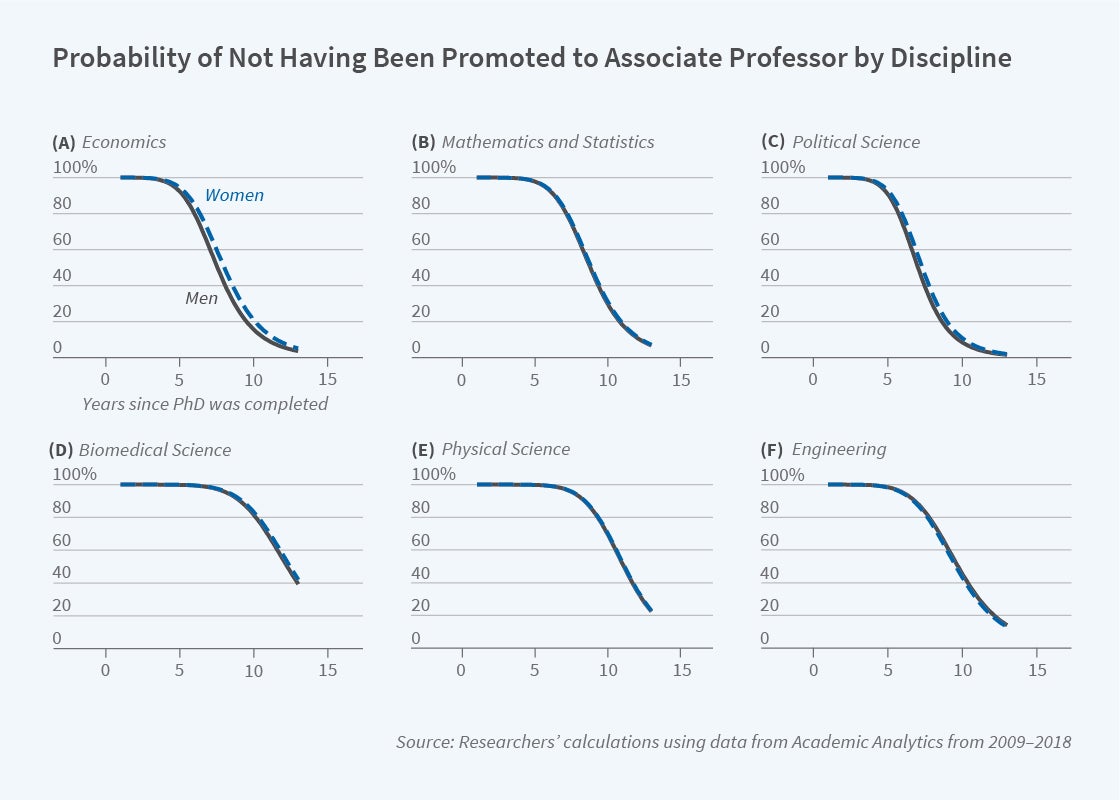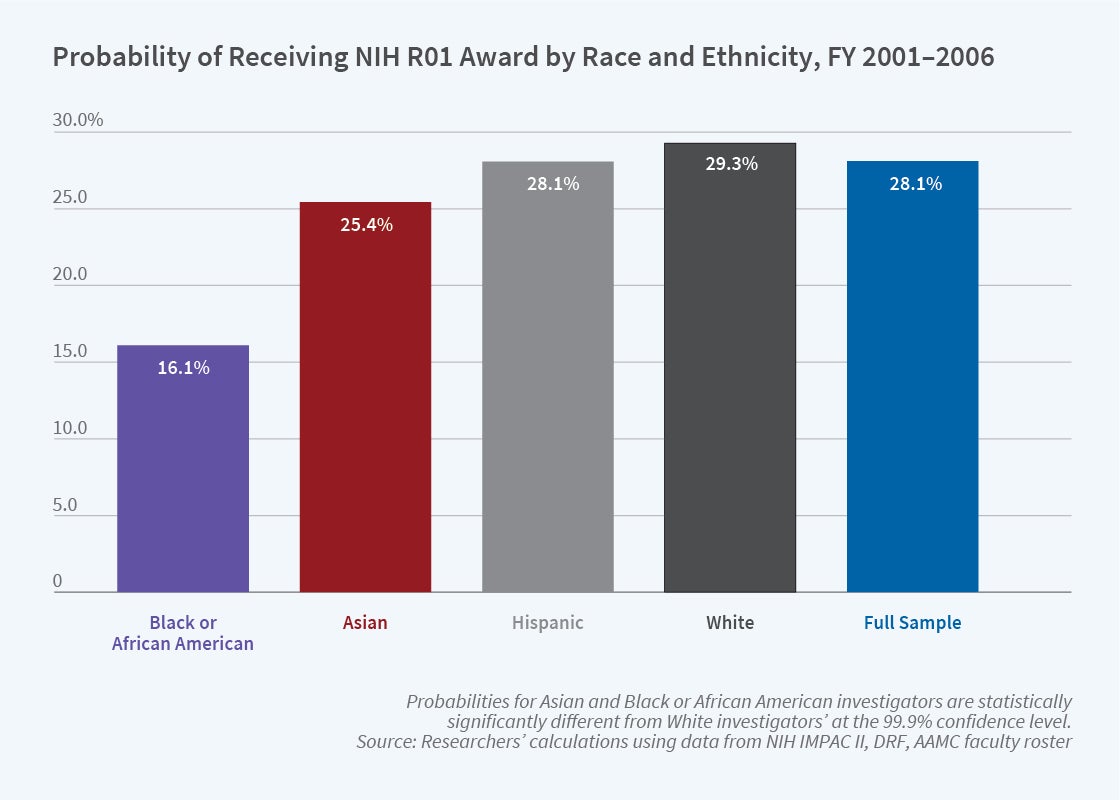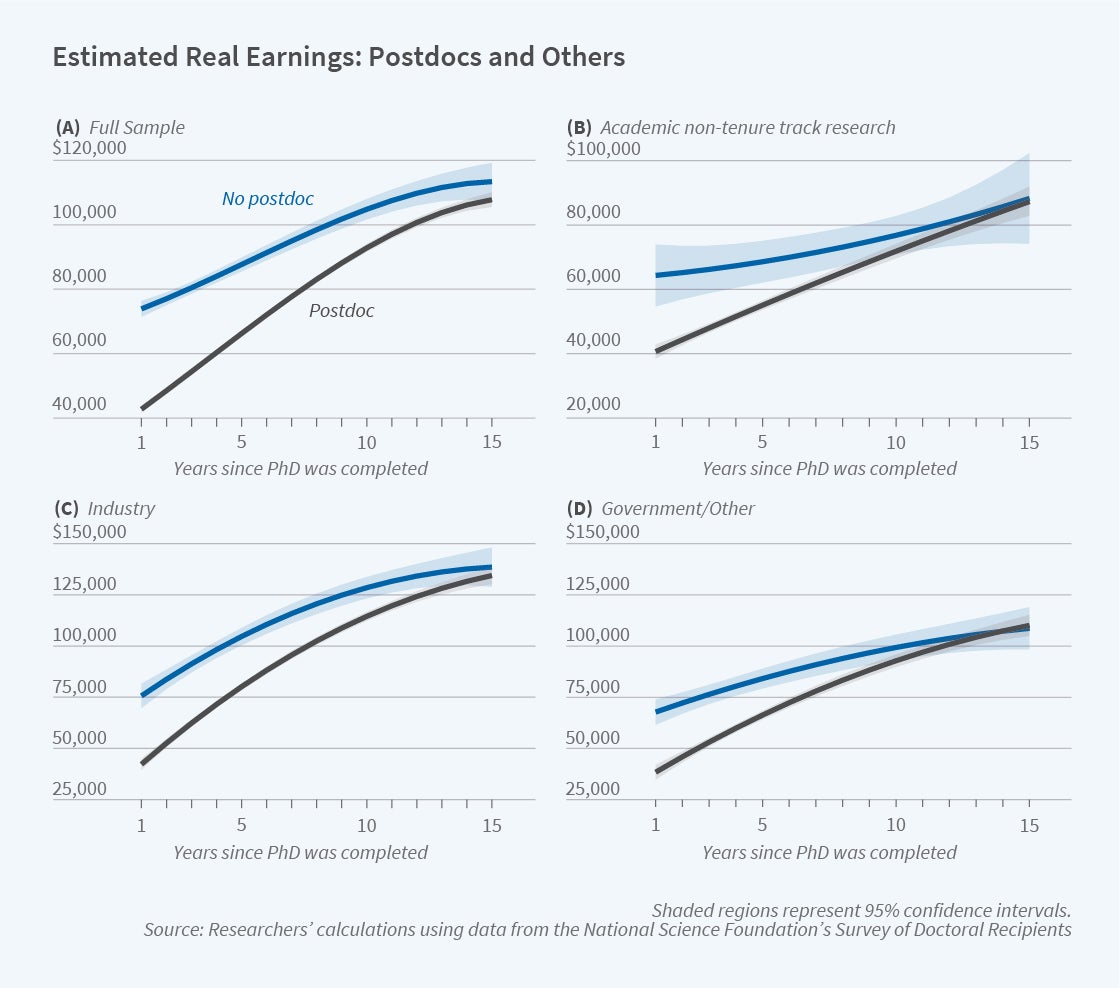Gender, Race, and Academic Career Outcomes — Does Economics Mirror Other Disciplines?
The textbook model of the labor market posits that workers are paid their marginal products. In this setting, equally productive workers should be paid and promoted at the same rate. While in the general labor market we are able to observe individual education, industry, occupation, and earnings, in most cases it is difficult to link individuals’ capital investments and productivity outcomes. My research has focused on academic labor markets because capital — in the form of federal research funding — and output — in the form of publications and citations — can be linked to individuals to yield new findings about academic careers and knowledge production.
Together with my collaborators, I have examined gender and race/ethnicity differences in research career outcomes as well as the effect of research funding on research productivity. New and improved datasets and administrative data have yielded key insights on these issues.
Gender Differences in Career Outcomes for Economists
With my long-time collaborator Shulamit Kahn, who has played a key role in this work, I have examined gender differences in career outcomes for economists and for other academic fields. We found that after controlling for research publications, women were significantly less likely to be promoted to tenure in economics.1 Our most recent study used Academic Analytics data to update the analysis of the economics profession compared with other science and social science fields.2 Figure 1 shows survival curves by gender and compares economics to the fields of mathematics and statistics, political science, biomedical science, physical science, and engineering. The only significant gender difference in promotion to associate professor is in economics, where women were 15 percent less likely to be promoted after controlling for publications, citations, and research grants.

We split the sample into top research and less research-intensive institutions, and our results suggest that women’s promotion disadvantage in economics is driven by lower-ranked research universities. The results also show that the gender parity in academic promotion in science careers that Kahn and I found using data through 2001 persists at least in research-intensive universities.3 Furthermore, our research shows that aggregating separate academic fields into the broad science, technology, engineering, and mathematics (STEM) category ignores the fact that each academic field constitutes a unique labor market. What is true of the economics profession does not generalize to other academic disciplines.
While women remain disadvantaged in academic careers in economics, the CeMENT program developed by the Committee on the Status of Women in the Economics Profession (CSWEP) and initially supported by a National Science Foundation grant to the American Economic Association has shown promise in improving women’s academic career outcomes. CeMENT was designed as a randomized controlled mentoring trial. Together with Francine Blau, Rachel Croson, and the head of the CeMENT research team, Janet Currie, we evaluated the impact of the program six years and 14 years after the first cohort began the mentoring process. Our interim evaluation found that women who participated in the two-and-a-half-day workshop published more papers overall and in top economics journals, and received more research funding than comparable scholars who did not participate.4 Our subsequent evaluation of six cohorts found that women who participated in CeMENT published more papers overall and in the top five journals, and were more likely to get tenure in the top 100 research departments.5
Work with Rina Na examined potential mechanisms behind CeMENT’s success. One can think of the CeMENT workshop as a random shock to professional networks. We found that women had significantly more coauthors after being mentored. These additional coauthors contributed to more publications. However, few of these women formed collaborations with women who attended the workshop. Instead, they added an average of three new coauthors in the profession. We interpret this result as showing women received tacit knowledge from the workshop that encouraged them to form more research collaborations.6
Gender and Race/Ethnicity Differences in Academic Careers
In addition to studying the economics profession, my coauthors and I have examined gender and race/ethnicity differences in STEM careers. In two separate reviews of the literature, we have examined the antecedents for women’s underrepresentation in math-intensive science fields: geoscience, engineering, economics, math and computer science, and physical science (GEEMP). Stephen Ceci, Wendy Williams, Kahn, and I examined the literature on gender differences in academic science careers in GEEMP fields where women are underrepresented and in life science, psychology, and social science fields (LPS — where social science excludes economics) where women have reached parity or are overrepresented.7
This review began with the literature on in utero conditions and early childhood and spanned the life course to academic career placements. We found significant gender differences in attitudes toward mathematics that emerged in kindergarten and led to lower propensities for girls to major in the mathematics-intensive GEEMP fields. However, gender differences in math performance primarily emerged after puberty and differed across countries and cultures. Our research found little evidence for bias against women in academic careers conditional on receiving a doctorate. We found that women were less likely to remain in academia in the LPS fields where they are overrepresented, but this is not true in the GEEMP fields. Kahn and I revisited this issue by focusing almost exclusively on the economics literature. As with our previous work, we distinguished between GEEMP and LPS fields and concluded that the roots of women’s underrepresentation in GEEMP fields starts in childhood, where girls lack role models and face biased views on women and mathematics achievement in their families or schools.8

What is true of gender differences in academic careers does not generalize to race/ethnicity differences. Using administrative data from the National Institutes of Health, Walter Schaffer, Joshua Schnell, Beth Masimore, Faye Liu, Laurel Haak, Raynard Kington and I examined race/ethnicity differences in the likelihood of receiving NIH R01 research awards. The R01 mechanism at NIH is designed for investigator-initiated research awards and is the mark of an independent research career. Figure 2 shows the race/ethnicity differences in R01 research awards. African American or Black investigators were half as likely to receive NIH funding as White investigators. Even after controlling for education, prior research awards, employer characteristics, and publications, we could explain less than 25 percent of the African American or Black/White funding gap.9 This research resulted in a series of working groups at NIH to investigate the lack of diversity of the biomedical workforce,10 and a 10-year, $500 million commitment to improve outcomes for African American or Black NIH investigators.11
Based on feedback from the advisory committee to the director of the NIH’s Working Group on Diversity in the Biomedical Research Workforce, Schaffer, Schnell, Kington and I, along with Jodi Basner and Unni Jensen, revisited the previous analysis by coding every line of nearly 2,400 NIH biosketches and matching the 54,000 publications listed on these biosketches to their bibliometric records. Our research showed that African American or Black investigators reported fewer papers on their biosketches, had fewer citations, and those that were reported appeared in journals with lower impacts. Using improved measures of publications, we were able to explain half of the African American or Black/White NIH funding gap.12 We also examined how careers diverged in terms of publications and citations. Although African American or Black investigators published the same number of papers during their PhD and postdoc years, these papers were cited less often. These results imply that African American or Black investigators may not receive the same advice from mentors as Whites related to research topics and publication strategies during doctoral training. These disadvantages accumulate as the African American or Black/White publication and citation gaps widen when African American or Black researchers become principal investigators.
Research Funding and Early Career Scientists
With Joshua Rosenbloom and other collaborators, I have also examined how research funding affects knowledge production in chemistry. We created a panel of the top 147 funded chemistry departments in the United States along with faculty, graduate student, and postdoc counts in the period 1990–2009. Rosenbloom, Joseph Heppert, Ted Juhl, and I found that research funding to academic chemistry departments increased publication and citation-weighted publications.13 In particular, our research identified rapid growth in chemistry knowledge production in the 1990s that we attributed to technological change in the form of lab computerization. In a follow-up study, Rosenbloom and I examined the determinants of institution-level chemistry research funding.14 We found that institutional funding was much more volatile than discipline-level funding for chemistry. Our estimates showed that research capacity in the form of numbers of postdocs and prior publications predicted subsequent research funding in chemistry. The fact that postdocs were a key input for future research funding underscores their importance to the scientific enterprise.
While postdocs are important predictors for institutional research funding, Kahn and I looked into the value of the postdoc to an individual’s career. It turns out to be “not much,” at least when it comes to earnings.15 Using data from the National Science Foundation’s Survey of Doctorate Recipients, we tracked people who started in a postdoc and then compared their outcomes to those of people who skipped the postdoc in biomedical research fields. We found that, over time, the probability of obtaining a tenure-track faculty position in biomedical fields has dropped dramatically, but despite that, the majority of PhDs in biomedicine start their careers in postdoctoral positions. However, the postdoc entails a significant opportunity cost: we found that former postdocs earned less than those who skipped the postdoc up to 10 years after the PhD. Figure 3 shows the estimated salaries of individuals who start in and skip the postdoc. Individuals who skip the postdoc have higher earnings for the first 13 years of their careers in the full sample (Panel A). We found similar salary penalties for non-tenure-track academic research, industry, and government employment sectors (Panels B, C, and D). Over the first 15 years of their careers, ex-postdocs earn 17 percent less than non-postdocs in non-tenure-track academic research, 21 percent less in industry, and 17 percent less in government. We concluded that the postdoc is not consistent with a human capital investment, and instead operates as a tournament for the limited number of tenure-track positions. The only benefit of doing a postdoc is its association with a tenure-track research position. By and large, we conclude, most young scientists would be economically better off skipping the postdoc.

However, not all postdocs are created equal. The NIH’s Advisory Committee to the Director on the Biomedical Workforce called for additional opportunities for postdoctoral fellowships.16 In two papers, we examined the causal impact of the NIH F32 fellowship — a mentored, independent postdoctoral fellowship — on career outcomes as well as the role of discretion in making these awards. Misty Heggeness, Maria Larenas, Frances Carter-Johnson, and I examined the causal impact of NIH F32 fellowships on subsequent NIH funding.17 Previous research by Brian Jacob and Lars Lefgren modeled the F32 fellowship using a regression discontinuity design, but we found evidence of significant discretion in F32 awards.18 Using propensity score methods, we found that receiving the F32 fellowship increased the probability of receiving an NIH R01 award by 49 percent.
Heggeness and I probed the role of discretion in awarding F32 fellowships, asking whether the NIH peer review process identifies the best science and most-promising future scientists. The answer is yes. NIH has a two-stage review process where proposals are first given an overall score. In the second stage, an NIH institute can make one of three decisions: 1) fund proposals in order given the score; 2) skip over higher scoring proposals and do not fund them in favor of ones more aligned with the institute’s scientific priorities; 3) reach for worse-scoring proposals and fund them because of institute priorities. Whenever an institute “skips” or “reaches” for a proposal, it is exercising discretion. We compared the outcomes of proposals that were funded in order based on their review score to those that received meritorious scores but were “skipped” and those that had worse scores and were “reached.” Those that were “reached” compared to not funded were 60 percent more likely to receive an R01 award. However, those that were “reached” were 35 percent less likely to receive subsequent R01 funding than those that were “skipped” and not funded. There was no significant difference in receiving an R01 award between those that were “skipped” and those that were funded in order.19 Thus, we concluded that the NIH F32 peer review process does a good job of identifying the most promising scientists early in their careers. Those with exemplary peer review scores are more likely to have independent research careers, regardless of whether they receive funding. Although peer review has many critics, our results indicate that it is an efficient method of allocating research funding compared with institutional discretion.
Endnotes
“Women in Economics: Moving Up or Falling Off the Academic Career Ladder?” Ginther D, Kahn S. Journal of Economic Perspectives 18(3), Summer 2004, pp. 193–214; “Academic Women’s Careers in the Social Sciences,” Ginther D, Kahn S. In The Economics of Economists: Institutional Setting, Individual Incentives, and Future Prospects, Lanteri A, Vromen J, editors, pp. 185–315. Cambridge, England: Cambridge University Press, 2014.
“Women in Academic Economics: Have We Made Progress?” Ginther D, Kahn S. NBER Working Paper 28743, April 2021, and American Economic Review Papers and Proceedings 111, May 2021, pp. 138–142.
“Does Science Promote Women? Evidence from Academia 1973–2001,” Ginther D, Kahn S. NBER Working Paper 12691, November 2006, and Science and Engineering Careers in the United States, Freeman R, Goroff D, editors. Chicago: University of Chicago Press, 2009.
“Can Mentoring Help Female Assistant Professors? Interim Results from a Randomized Trial,” Blau F, Currie J, Croson R, Ginther D. NBER Working Paper 15707, January 2010, and American Economic Review 100(2), May 2010, pp. 348–352.
“Can Mentoring Help Female Assistant Professors in Economics? An Evaluation by Randomized Trial,” Ginther D, Currie J, Blau F, Croson R. NBER Working Paper 26864, December 2020, and American Economic Review Papers and Proceedings 110, May 2020, pp. 205–209.
“Does Mentoring Increase the Collaboration Networks of Female Economists? An Evaluation of the CeMENT Randomized Trial,” Ginther D, Na R. NBER Working Paper 28727, April 2021, and American Economic Review Papers and Proceedings 111, May 2021, pp. 80–85.
“Women and STEM,” Kahn S, Ginther D. NBER Working Paper 23525, June 2017. Published as “Women in Academic Science: A Changing Landscape” in Psychological Science in the Public Interest 15(3), November 2014, pp. 75–141.
“Women and STEM,” Kahn S, Ginther D. NBER Working Paper 23525, June 2017. Published as “Women and Science, Technology, Engineering and Mathematics (STEM): Are Differences in Education and Careers due to Stereotypes, Interests or Family?” in The Oxford Handbook of Women and the Economy, Averett S, Argys L, Hoffman S, editors. New York: Oxford University Press, 2018.
“Race, Ethnicity, and NIH Research Awards,” Ginther D, Schaffer W, Schnell J, Masimore B, Liu F, Haak L, Kington R. Science 333(6045), August 19, 2011, pp. 1015–1019.
“Draft Report of the Advisory Committee to the Director Working Group on Diversity in the Biomedical Research Workforce,” June 13, 2012, https://acd.od.nih.gov/documents/reports/iversityBiomedicalResearchWorkforceReport.pdf
“NIH Launches Effort to Boost Diversity of Biomedical Research Workforce,” December 7, 2012. https://www.science.org/content/article/nih-launches-effort-boost-diversity-biomedical-research-workforce-rev2
“Publications as Predictors of Racial and Ethnic Differences in NIH Research Awards,” Ginther D, Basner J, Jensen U, Schnell J, Kington R, Schaffer W. PLOS ONE 13(11): e0205929, November 14, 2018.
“The Effects of Research & Development Funding on Scientific Productivity: Academic Chemistry, 1990–2009,” Rosenbloom J, Ginther D, Juhl T, Heppert J. NBER Working Paper 20595, October 2014, and PLOS ONE 10(9): e0138176, September 15, 2015.
“Show Me the Money: Federal R&D Support for Academic Chemistry, 1990–2009,” Rosenbloom J, Ginther D. NBER Working Paper 23555, June 2017, and Research Policy 46(8), October 2017, pp. 1454–1464.
“The Impact of Postdocs on Early Careers in Biomedicine,” Kahn S, Ginther D. Nature Biotechnology 35(1), January 2017, pp. 90–94.
“Biomedical Research Workforce Working Group Report,” June 14, 2012. https://biomedicalresearchworkforce.nih.gov/docs/Biomedical_research_wgreport.pdf
“The Impact of Postdoctoral Fellowships on a Future Independent Career in Federally Funded Biomedical Research,” Heggeness M, Ginther D, Larenas M, Carter-Johnson F. NBER Working Paper 24508, April 2018.
“The Impact of NIH Postdoctoral Training Grants on Scientific Productivity,” Jacob B, Lefgren L. Research Policy 40(6), July 2011, pp. 864–874.
“Administrative Discretion in Scientific Funding: Evidence from a Prestigious Postdoctoral Training Program,” Ginther D, Heggeness M. NBER Working Paper 26841, March 2020, and Research Policy 49(4), May 2020, article 103953.


